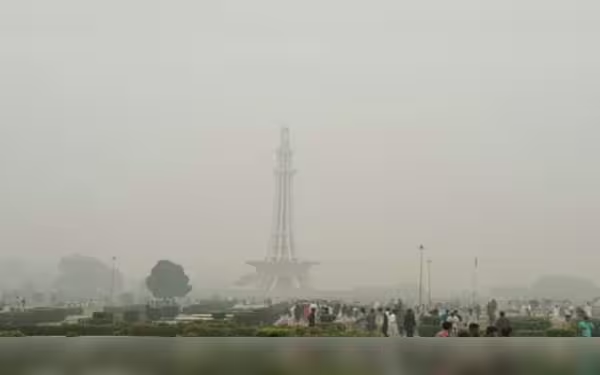Thursday, November 7, 2024 01:29 AM
Lahore Smog Crisis: AQI Exceeds 1000, Health Risks Surge
- Lahore's AQI reaches hazardous level of 1,165.
- Over 55,000 eye infections reported in Punjab.
- Punjab government establishes 'smog war room' for pollution control.
 Image Credits: nation_pk
Image Credits: nation_pkLahore faces a severe smog crisis with AQI exceeding 1,000, prompting health warnings and government action.
Lahore, the vibrant heart of Pakistan, is currently facing a grave environmental crisis as it has once again topped the global smog rankings. The city's Air Quality Index (AQI) has soared beyond 1,000, marking it as the most polluted city in the world. This alarming situation was highlighted on Wednesday when data from the Swiss monitoring agency IQAir revealed that Lahore's AQI reached a staggering 'hazardous' level of 1,165 early in the day. This level of pollution is driven primarily by high concentrations of PM2.5 particles, which are 125 times higher than the limits recommended by the World Health Organization (WHO).
As the day progressed, the AQI slightly decreased to 1,099 but remained firmly in the hazardous category. This ongoing pollution wave has been particularly severe, with AQI figures peaking at 1,194 earlier this week. The impact of this pollution is being felt across the province, with the Punjab Health Department reporting a significant increase in health issues related to pollution. Over 55,000 cases of eye infections have been reported across Punjab, with more than 7,000 of those cases occurring in Lahore alone from October 21 to 27. Additionally, more than 6,000 residents have reported respiratory problems, prompting health experts to recommend that people increase their hydration to combat the effects of the smog.
Currently, Lahore's AQI stands at 751, with particulate matter levels still 90 times higher than WHO standards. In comparison, New Delhi ranks second on the global pollution chart with an AQI of 364. In response to this deteriorating air quality, the Punjab government has established a 'smog war room.' This initiative involves officials from eight different departments who will monitor pollution sources and review weather forecasts on a daily basis. The government plans to conduct assessments twice a day to guide pollution control measures, which may include limiting traffic and preventing farm fires, along with issuing daily advisories to the public.
Despite these efforts, the situation remains dire. Last week's peak AQI of 1,900 led to temporary school closures and remote work orders, highlighting the urgent need for effective solutions. Punjab's senior minister, Marriyum Aurangzeb, has suggested that cross-border pollution from India may be contributing to the worsening air quality. Each winter, South Asia experiences a thick blanket of pollution due to trapped emissions, which researchers warn could reduce life expectancy in the region by over five years.
As residents of Lahore navigate this challenging environment, it is crucial for everyone to stay informed and take necessary precautions. The health risks associated with such high levels of pollution are significant, and it is essential for individuals to protect themselves and their families. While government initiatives are a step in the right direction, collective action and awareness are vital in combating this pressing issue. The fight against pollution is not just a local concern; it is a global challenge that requires cooperation and commitment from all sectors of society.













